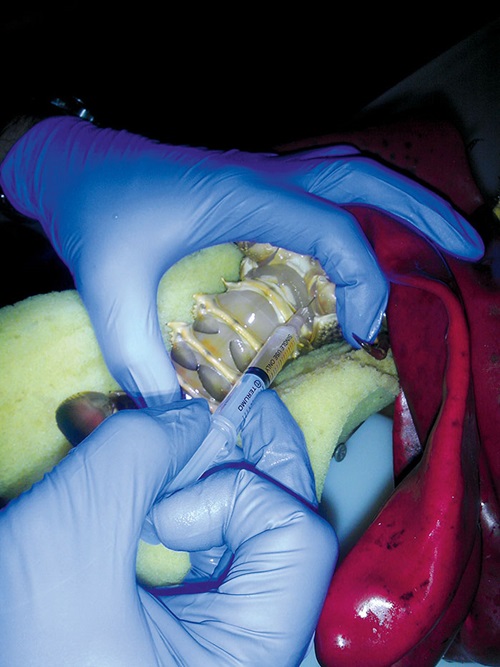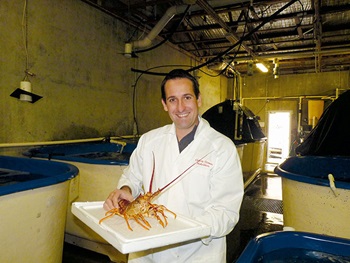Innovative research in Tasmania may lead to new industry practices in Australia’s valuable rocklobster industry
By Georgie Raik-Allen
 A blood sample drawn from a juvenile rocklobster is used to assess the condition and nutritional needs of the animal.
A blood sample drawn from a juvenile rocklobster is used to assess the condition and nutritional needs of the animal. World-first techniques to assess the quality of rocklobster meat in live animals could lead to improved quality in rocklobster exports and optimise returns for fishers and exporters.
Tasmanian researcher Cedric Simon has delivered promising results from a 12-month research project to adapt standard veterinarian diagnostic equipment to measure blood samples for quick and simple assessment of the condition of rocklobsters.
The traditional method for determining the nutritional condition of the rocklobster is to destroy the animal and examine its organs. Assessing the condition of a rocklobster without dissecting it is difficult because the hard shell shields the meat of the animal from view.
Cedric Simon is collaborating with international researchers to investigate non-destructive ways to assess the nutritional status of the live rocklobster.
He has taken blood samples from Eastern Rocklobsters (Jasus verreauxi) and Southern Rocklobsters (Jasus edwardsii) and sent them to Canadian scientists to conduct in-depth analysis of blood biochemistry.
About 30 different factors have been investigated as a potential measure of health, including rocklobsters fed an optimal diet of fresh mussels compared with those that have been starved for set periods of time.
“The automated blood analyser provides many different measurements that assist in better teasing out nutritional condition,” Cedric Simon explains. “These include protein, fat and mineral content of the blood.”
His initial findings are encouraging. “So far, the ratio of two types of protein in the blood has provided a good indication of the condition of the rocklobster, regardless of where the animal is in its moult cycle.”
In a world first, Cedric Simon is also adapting other techniques, including infrared technology, typically used to assess the condition of land animals such as cattle and horses, to evaluate the quality of the rocklobster meat.
He is using near-infrared (NIR) spectroscopy to measure the carbon content of the tail muscle. Infrared light is reflected differently depending on the composition of the muscle tissue. A higher concentration of carbon is found in healthier rocklobsters.
 Science and Innovation Award winner Cedric Simon.
Science and Innovation Award winner Cedric Simon. Photo: University of Tasmania
He is producing a NIR model for rocklobster species that will predict how much carbon is in the tail of rocklobsters and provide more information about the condition of the animal.
While this research is being trialled in the laboratory on tails that have been frozen and then thawed, Cedric Simon says the next stage will be to use portable equipment and conduct the research on live rocklobsters on a boat or in a holding facility.
As international demand for rocklobsters grows and the world’s supply of rocklobster stock declines, research with the potential to maximise the quality of rocklobsters and improve the value of a catch is attracting significant interest. Being able to assess the condition of the rocklobster with non-destructive techniques is important, as animals are shipped and sold live for high prices.
They are also extremely valuable alive as broodstock to produce larvae for potential farming.
Consumer demand is particularly strong in countries such as China and India where high-status ‘party food’ such as rocklobster is increasingly popular in the growing middle and upper classes.
According to Cedric Simon, the Australian seafood industry is well managed and the quality of seafood product remains high.
The rocklobster market is worth an estimated $400 million in Australia, with about 80 per cent of the catch exported to Hong Kong and China.
Most rocklobsters are caught in the wild and kept in live holding facilities while rocklobster exporters wait for the best sale price. While kept in those facilities and during shipping to destination countries, stress and reduced food consumption can cause rocklobsters to lose condition and even die, which can affect the price of the whole batch.
Cedric Simon’s research is expected to benefit the rocklobster fishing and aquaculture industries by leading to new techniques to quickly assess the nutritional status of the animals, knowledge that can be used to maintain their condition in live holding facilities and during shipping.
He hopes the research will also contribute to new methods to grow low-condition rocklobsters to market size. Rocklobsters that would have been rejected could instead be ‘fattened up’ in captivity to reach the optimal colour and nutritional status to attract the best market price.
Improving the quality and appeal of rocklobsters’ diets in culture has been an interest of Cedric Simon since he completed his PhD on the topic of developing formulated diets for Southern Rocklobster juveniles in New Zealand.
“We still haven’t found a perfect formulated diet for rocklobsters and they don’t grow as well in culture as they do in the wild,” Cedric Simon says.
Along with the development of effective culture systems and conditions suitable for both the larvae and juvenile rocklobsters to grow, improvements in formulated diets could contribute to the development of large-scale commercial farming of rocklobsters.
“It’s a huge area of growth, once you crack that, you have answered the million-dollar question,” Cedric Simon says. However, he cautions that research is in its early stages and there is still much work to be done.
His 12-month project will conclude after he travels to Canada later this year to modify the technology he has been using to suit Australian conditions. Eventually, he hopes the technology will be incorporated into affordable handheld devices for direct and easy use on boats or at live holding facilities. It may also be applicable to other crustacean species.
The technology may also have broader applications. For example, it could be used to monitor the impact of global warming and other external factors on the health and feeding status of rocklobster populations in different oceans.
Cedric Simon’s project was funded by the FRDC as the winner of the 2012 Science and Innovation Award for Young People in Agriculture, Fisheries and Forestry. He received additional funding for the project as the winner of the Minister for Agriculture, Fisheries and Forestry’s Award, announced at the same time.
More information
Cedric Simon, 03 6227 7299
cedric.simon@utas.edu.au





